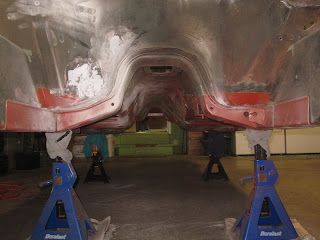Our Consul came with the 2495 cc (152 ci) Essex V6 power unit - this motor was produced in the UK at the Ford plant in Dagenham, Essex, and is not to be confused with the Canadian Essex V6 built at the Essex Engine Plant in Windsor, Ontario. Ford also offered the modded-out Consul L, and a performance GT package which included the larger 2994 cc Essex V6 and boasted 138 bhp. Since the Consul was less well equipped than the similarly powered Granada it was approximately 1 cwt lighter - and MUCH quicker off the line. My father always claimed the car was "built to cruise at 90 mph" but it never went near that speed while I was a passenger.
Of course the most significant feature of the car was the special order paint: Ford called this exceptionally bright shade Le Mans Green (paint code M in 1972-3), in honor of their GT40's decimation of the Ferrari challenge at the famous 24 hours endurance race for four consecutive years from 1966. The choice of color was actually influenced by a similar though darker colored Lotus once spotted in Hull. When my father ordered the car at Dees of Croydon in early 1973, even the sales manager asked if sir was "quite sure about the color?" After the dealership took delivery the manager made some additional comments about the paint's stunning glow putting his staff "off their lunches"!
In addition to the paint, the car was ordered with several other options including power brakes, wider wheels (plus one inch from stock), radio/cassette delete, nylon inserts sewn into the otherwise vinyl seats, and...wait for it...a sun roof! If the color didn't make the car a one of one then the sunroof surely did. The back up lights were aftermarket lenses over a couple of bulbs plugged straight into the stock wiring harness and were added by a family friend. Dad made up for the lack of a radio by installing an aftermarket cassette player and one speaker which only ever played Stevie Wonder, but the one option the car really could have done with was power steering.
In the fifteen or so years that my family owned the Consul, we never saw another one with the same paint job. My father once said it was a young man's color on a family car, and that's probably fair comment because there were a few Le Mans green Escorts on the street back then; mostly not as nice as the example below it has to be said. This picture actually gives a better idea of what the original color was really like - the other pictures are scanned slides which have faded with age...but then haven't we all.
The Consul was sold for 85 quid around 1988 to be used for banger racing - at the time we we glad to see it go since it had become terribly unreliable - in fact my father had nicknamed the car the "green heap". Of course the car has never been forgotten - even by Ford, who revived the Le Mans Green name in 2009 for a special edition Focus...not exactly the same color, but still cool:
Recently I've been trying to find pictures of other Le Mans Green cars, but when it comes to the Consul I can only find pictures of a model - with the GT fog lamps and a black sports roof...the more sporty cars in the Ford range are a little bit easier to track down.
 |
| Model of Consul GT with sports roof |
 |
| Mark I Ford Capri |
 |
| 70's Ford Cortina |
 |
| 70's Ford Escort |











































